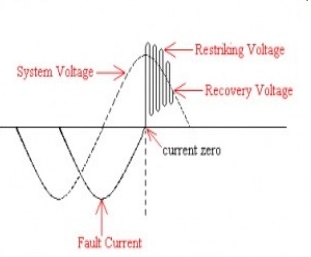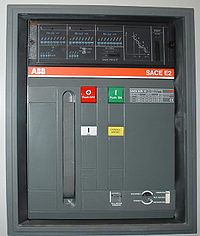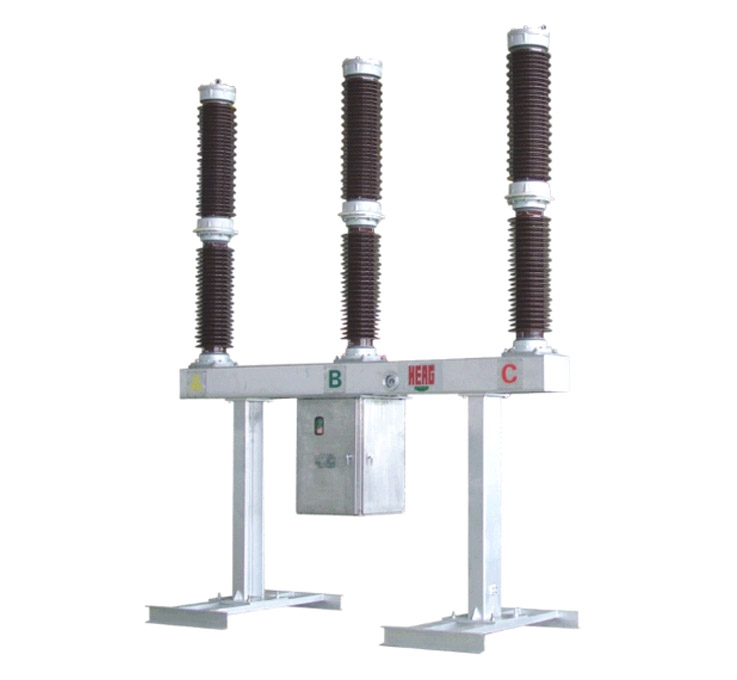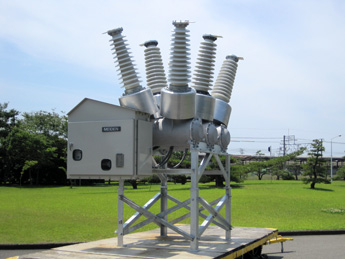It is well known that Circuit Breakers are devices which are used to break a circuit continuity and restore it again when required. Normally these are known as switching devices that can be activated manually or automatically to control the electrical power systems. In case of short circuiting or leakage of the larger amount of the current circuit breakers are activated automatically to disconnect the power line. Modern power systems due to the huge demand of power load are now dealing huge amount of current therefore smart designing of Circuit Breakers should be such that no arc is produced in order to achieve loss free functioning of any power distribution system or substation.
A circuit breaker is a mechanical switching device, capable of making, carrying and breaking currents under normal circuit conditions. It is also capable of making and carrying currents for a specified time and breaking currents under specified abnormal circuit conditions, such as those of a short circuit.
WORKING PRINCIPLE OF CIRCUIT BREAKERS
Operating Principle Two contacts called electrode remains closed under normal operating conditions. When fault occurs on any part of the system, the trip coil of the circuit breaker get energized and contacts are separated.
Typically circuit breaker consists of fixed contacts and moving contacts. The physical connection between the two current carrying contacts due to the applied mechanical pressure on the moving contacts, make the “on” state of the circuit breaker. The potential energy can be stored in the circuit breaker by different ways:-
- Deforming metal spring
- Compressed air
- Hydraulic pressure
This stored potential energy is the main factor in the working of the circuit breaker and it must be released whenever the signal is given for it. This causes tremendously fast sliding of the moving contact as it is required. All circuit breaker have operating coils (tripping coils and close coil), whenever these coils are energized by switching pulse, the plunger inside them gets displaced. This operating coil plunger is typically attached to the operating mechanism of circuit breaker and the moving contacts are mechanically connected with this operating mechanism through a gear lever arrangement. There is a conversion of stored potential energy into kinetic energy, which makes the moving contact to move. Once the cycle of circuit breaker operation is complete i.e. it is tripped, the total energy is again stored in the form of potential energy by means of spring charging motor or air compressor or by any other means.
The circuit breaker has to carry large rated also called the fault power. While carrying this large power there is always a risk of dangerously high arcing between the moving and the fixed contacts during the circuit breaker operation when it is charged. For safe arc quenching in the circuit breaker, the dielectric strength between the current carrying contacts should be increased rapidly during every zero current crossing of the alternating current. The dielectric strength of the media in between contacts can be increased in numbers of ways:-
- Compressing the ionized arcing media since compressing accelerates the deionization process of the media
- Cooling the arcing media since cooling increase the resistance of arcing path
- Replacing the ionized arcing media by fresh gasses.
What is an Arc
During opening of current carrying contacts in a circuit breaker the medium in between opening contacts become highly ionized through which the interrupting current gets low resistive path and continues to flow through this path even the contacts are physically separated. During the flowing of current from one contact to other the path becomes so heated that it glows. This is called arc. Whenever, on load current contacts of circuit breaker open there is an arc in circuit breaker, established between the separating contacts. As long as this arc is sustained in between the contacts the current through the circuit breaker will not be interrupted finally as because arc is itself a conductive path of electricity. For total interruption of current the circuit breaker it is essential to quench the arc as quick as possible. The main designing criteria of a circuit breaker is to provide appropriate technology of arc quenching in circuit breaker to fulfill quick and safe current interruption.
TYPES OF CIRCUIT BREAKERS
AIR CIRCUIT BREAKERS – ACB
This type of circuit breakers, is those kind of circuit breaker which operates in air at atmospheric pressure. After development of oil breaker, the medium voltage air circuit breaker (ACB) is replaced completely by oil circuit breaker in different countries. But in countries like France and Italy, ACBs are still preferable choice up to voltage 15 KV. It is also good choice to avoid the risk of oil fire, in case of oil circuit breaker. In America ACBs were exclusively used for the system up to 15 KV until the development of new vacuum and SF6 circuit breakers. There are mainly two types of ACB available i.e. Plain air circuit breaker and Air blast Circuit Breaker.
Working principle of Air Circuit Breaker – ACB
The working principle of this breaker is rather different from those in any other types of circuit breakers. The main aim of all kind of circuit breaker is to prevent the reestablishment of arcing after current zero by creating a situation where in the contact gap will withstand the system recovery voltage. The air circuit breaker does the same but in different manner. For interrupting arc it creates an arc voltage in excess of the supply voltage. Arc voltage is defined as the minimum voltage required maintaining the arc. This circuit breaker increases the arc voltage by mainly three different ways.
- By increasing the arc voltage by cooling the arc plasma. As the temperature of arc plasma is decreased, the mobility of the particle in arc plasma is reduced; hence more voltage gradient is required to maintain the arc.
- It may increase the arc voltage by lengthening the arc path. As the length of arc path is increased, the resistance of the path is increased, and hence to maintain the same arc current more voltage is required to be applied across the arc path. That means arc voltage is increased.
- Splitting up the arc into a number of series arcs also increases the arc voltage.
SF6 CIRCUIT BREAKER
In this type of circuit breakers current carrying contacts are immersed in Sulphur Hexafluoride gas. SF6 gas has a high affinity of absorbing free electrons as its electro-negativity is very high. Moreover, SF6 is an excellent insulator. The SF6 molecules absorb the free electrons from the arc, and hence form a negative ion. These negatively charged ions have a very low mobility compared to the free electrons. Hence there is no arcing as the mobility of the charges is the main reason of movement of current through the gas.
SF6 has a very high dielectric property and not only that, its molecules recombine very fast after the arcing has stopped. The gas can also transfer heat very efficiently through convection due to its low viscosity. Considering all these properties of SF6, it becomes 100 times more effective than air to be used in circuit breakers. Hence they can be used for voltage ranges from 33KV to 800KV and beyond.

SF6 Circuit Breaker
Advantages of SF6 Circuit Breakers
- Simple construction, less cost.
- SF6 gas is non flammable, non toxic & chemical inert gas.
- Same gas is recirculated in the circuit.
- Maintenance free C.B.
- Ability to interrupt low and high fault current.
- Excellent Arc extinction.
Disadvantages of SF6 Circuit Breakers
- SF6 is a greenhouse gas and the circuit breaker must be manufactured and handled carefully in order to prevent its release into the atmosphere.
- The design of these types of circuit breakers requires almost five times greater mechanical energy than oil circuit breakers for their proper functioning.
VACUUM CIRCUIT BREAKERS
These type of circuit breakers use vacuum for the arc quenching. Vacuum circuit breakers are mostly used in medium voltage distribution systems / applications. Vacuum interrupter is a vacuum chamber in the breaker where all the operations of opening and closing of contacts and linked arc quenching takes place. The vacuum pressure inside the vacuum interrupter is generally maintained at 6-10 bar. The interrupter is basically a steel arc chamber in the center of symmetrically arranged ceramic insulators.
CuCr is generally used to make vacuum circuit breaker contacts, because these current carrying contacts are very important for the performance of these circuit breakers. Vacuum circuit breaker is a developing technology, although it was first introduced in 1960’s. Its size has been greatly reduced and the contact geometry has evolved from butt contact to spiral shape, cup shape and axial magnetic field contact. These are one of the most reliable for use in medium voltage switch gears and require least maintenance.

Vacuum circuit Breaker
Advantages of Vacuum Circuit Breakers
- Compact, reliable and have longer life.
- No fire hazards.
- No generation of gas during and after operation.
- Can interrupt any fault current.
- No noise is produced while operating.
- Require less power for control operation.
OIL CIRCUIT BREAKERS
Low Oil Circuit Breaker Consists of two parts i.e. supporting chamber & Circuit-Breaking chamber i.e. fixed and moving contact.
Disadvantages Of Oil Circuit Breaker
- It is inflammable and there is a risk of fire.
- May form an explosive mixture with air.
- It requires maintenance.
- Absorbs moisture, so dielectric strength reduces.
- Oil leakage problem.
- Oil has to be replaced after some operations because of the carbonization of oil.
Discover more from Electrical Engineering 123
Subscribe to get the latest posts sent to your email.

